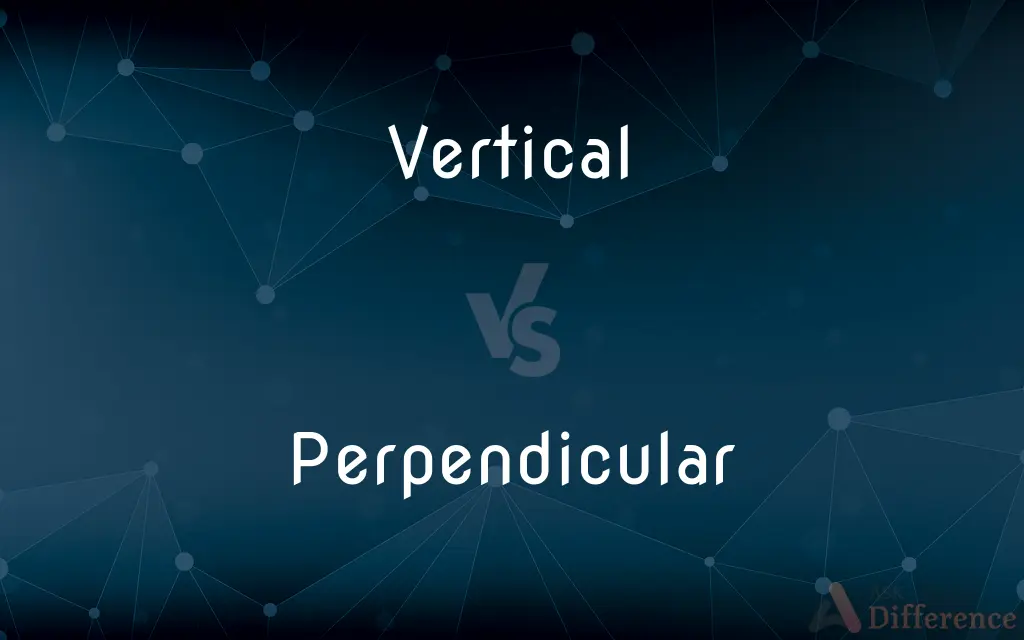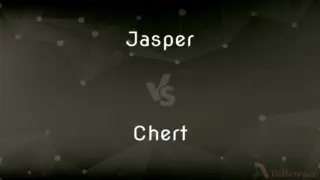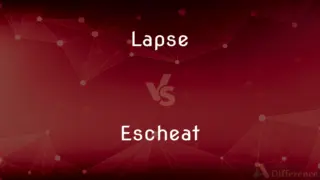Vertical vs. Perpendicular — What's the Difference?
By Urooj Arif & Fiza Rafique — Updated on February 28, 2024
Vertical refers to being upright or at a right angle to the horizon, while perpendicular specifically denotes a 90-degree angle between two lines or planes, regardless of orientation.

Difference Between Vertical and Perpendicular
Table of Contents
ADVERTISEMENT
Key Differences
Verticality is a directional concept, suggesting something is standing up straight in relation to the Earth's surface, as in the case of a skyscraper or a standing person. Perpendicularity, however, focuses on the angle relationship between two intersecting lines or planes, emphasizing that the angle is exactly 90 degrees. While all vertical lines are perpendicular to the horizon, not all perpendicular lines are vertical.
A vertical line runs up and down, parallel to the y-axis on a graph, and is used to describe objects or lines that mimic this orientation. Perpendicular lines or surfaces intersect at any angle, as long as it's a right angle, showing a broader application in mathematics and design, such as the relationship between the walls and the floor of a room.
Vertical positions are often related to gravity, indicating an alignment opposite to the force of gravity, providing a sense of balance or elevation. Perpendicular relationships do not inherently relate to gravity but to the geometric criteria of forming right angles, important in constructing and ensuring stability in architecture and engineering.
The term vertical can also imply a hierarchy or order, such as in vertical integration in business, where a company controls multiple stages of production or distribution. Perpendicular has no such connotation and remains a purely geometric term, used to describe spatial relationships.
Verticality is a key concept in fields like architecture, urban planning, and art, where the visual impact and structural integrity of vertical elements are crucial. Perpendicularity is essential in design, construction, and mathematics, ensuring that structures meet at right angles for aesthetic and functional reasons.
ADVERTISEMENT
Comparison Chart
Definition
Being upright or at a right angle to the horizon.
Meeting or intersecting at a right angle (90 degrees).
Orientation
Specifically up and down.
Any orientation, as long as it forms a right angle.
Relation to Gravity
Often related to opposing gravity.
No inherent relation to gravity.
Geometric Usage
Describes orientation.
Describes the angle relationship between two lines or planes.
Practical Application
Used in architecture, urban planning, art.
Crucial in design, construction, mathematics.
Symbolism
Can symbolize hierarchy or order.
Purely geometric, without symbolic meaning.
Compare with Definitions
Vertical
Vertical growth refers to building upwards.
The city's vertical growth is evident in its skyline.
Perpendicular
Perpendicular forces in physics involve 90-degree interactions.
The perpendicular forces result in stable equilibrium.
Vertical
Vertical integration in business controls the supply chain.
The company's vertical integration helped control costs.
Perpendicular
Carpentry relies on perpendicular cuts for corners.
Accurate perpendicular cuts are essential for the frame.
Vertical
A vertical flagpole stands upright against the sky.
The vertical flagpole is visible from miles away.
Perpendicular
Perpendicular streets intersect at right angles.
The city's grid layout features streets that are perpendicular to each other.
Vertical
Vertical lines in art create a sense of height.
The painting used vertical lines to evoke towering trees.
Perpendicular
A ladder leans perpendicular to the ground.
Ensure the ladder is perpendicular to the wall for safety.
Vertical
A vertical jump tests athletic ability.
Basketball players often excel in vertical jumps.
Perpendicular
Perpendicular design in architecture ensures stability.
The beams are perpendicular to the floor for support.
Vertical
Being or situated at right angles to the horizon; upright.
Perpendicular
In elementary geometry, the property of being perpendicular (perpendicularity) is the relationship between two lines which meet at a right angle (90 degrees). The property extends to other related geometric objects.
Vertical
Situated at the vertex or highest point; directly overhead.
Perpendicular
At an angle of 90° to a given line, plane, or surface or to the ground
Dormers and gables that extend perpendicular to the main roofline
Vertical
A vertical geometrical figure; a perpendicular.
Perpendicular
A straight line at an angle of 90° to a given line, plane, or surface
At each division draw a perpendicular representing the surface line
Vertical
An individual slat in a set of vertical blinds.
Perpendicular
Being at right angles to the horizontal; vertical.
Vertical
A vertical component of a structure.
Perpendicular
A perpendicular position.
Perpendicular
A straight line at right angles to another line
Perpendicular
Intersecting at or forming right angles;
The axes are perpendicular to each other
Parallel lines never converge
Concentric circles are parallel
Dancers in two parallel rows
Perpendicular
At right angles to the plane of the horizon or a base line;
A vertical camera angle
The monument consists of two vertical pillars supporting a horizontal slab
Measure the perpendicular height
Common Curiosities
What makes a line vertical?
A line is vertical if it runs up and down, perpendicular to the horizon, and parallel to the direction of gravity.
How do you know if two lines are perpendicular?
Two lines are perpendicular if they intersect to form a right angle (90 degrees).
What is the significance of perpendicular design?
Perpendicular design is crucial for creating right angles in construction and architecture, ensuring stability and a pleasing aesthetic.
Can perpendicular lines be horizontal?
Yes, perpendicular lines can be horizontal as long as they intersect another line at a 90-degree angle.
Is vertical always up and down?
Yes, vertical implies an up-and-down orientation relative to the Earth's surface.
Why is verticality important in construction?
Verticality ensures structural integrity and aesthetic appeal in construction, aligning with gravity for stability.
Can an object be both vertical and perpendicular?
An object can be vertical and part of a perpendicular relationship if it intersects another line or plane at a right angle.
Can the concept of vertical apply to non-physical spaces?
Yes, in a metaphorical sense, vertical can describe hierarchies or order within systems, such as in organizations.
Can vertical lines intersect?
Vertical lines can intersect with other lines, but two perfectly vertical lines, in the same plane, will not intersect with each other.
How does gravity affect verticality?
Gravity provides a reference direction for verticality, with vertical objects aligning against or with the direction of gravitational pull.
How does vertical differ from horizontal?
Vertical refers to an up-and-down orientation, while horizontal implies a side-to-side orientation, parallel to the horizon.
Is perpendicularity a relative concept?
Perpendicularity is based on the geometric relation of lines or planes and is not relative but defined by the precise angle of intersection.
How do vertical and perpendicular concepts apply in nature?
In nature, vertical structures like trees oppose gravity, while perpendicular relationships are seen in various forms, such as branches extending from tree trunks.
Do perpendicular lines have to cross?
Yes, by definition, perpendicular lines intersect each other, forming a right angle.
What tools measure vertical or perpendicular alignment?
Tools like levels, plumb bobs, and squares are used to measure verticality and perpendicularity.
Share Your Discovery

Previous Comparison
Jasper vs. Chert
Next Comparison
Lapse vs. EscheatAuthor Spotlight
Written by
Urooj ArifUrooj is a skilled content writer at Ask Difference, known for her exceptional ability to simplify complex topics into engaging and informative content. With a passion for research and a flair for clear, concise writing, she consistently delivers articles that resonate with our diverse audience.
Co-written by
Fiza RafiqueFiza Rafique is a skilled content writer at AskDifference.com, where she meticulously refines and enhances written pieces. Drawing from her vast editorial expertise, Fiza ensures clarity, accuracy, and precision in every article. Passionate about language, she continually seeks to elevate the quality of content for readers worldwide.














































